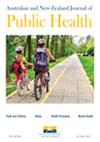与偏远原住民社区一起学习实现健康皮肤的下一步措施
IF 2.4
3区 医学
Q2 PUBLIC, ENVIRONMENTAL & OCCUPATIONAL HEALTH
Australian and New Zealand Journal of Public Health
Pub Date : 2025-04-11
DOI:10.1016/j.anzjph.2025.100242
引用次数: 0
摘要
皮肤健康被广泛认为对整体健康和福祉很重要,但在偏远的土著社区,皮肤感染的负担仍然很高。该项目旨在探索对皮肤健康的虚拟支持是否可以成为减少社区参与皮肤健康障碍的一种策略。方法本研究采用参与式行动研究设计中的编织方法收集定性数据。我们聘请了一位对研究所在国家、语言和社区非常熟悉的社区合作研究员来指导研究过程。结果最终数据集包括对21名参与者的访谈。确定了三个主要主题,包括:通过教育和皮肤检查进一步深入社区,虚拟皮肤健康支持不是首选,但可以接受,环境健康不容忽视。结论与会者就改善社区内健康促进信息传递提出了若干建议,同时强调需要更加关注环境卫生。聘用一名社区共同研究员是提供研究方法的必要条件。该项目进一步证明了在偏远土著社区开展研究时社区参与、包容和能力建设的重要性,以及双向学习作为良好研究实践基础的好处。本文章由计算机程序翻译,如有差异,请以英文原文为准。
Yarning with a remote Aboriginal community about the next steps for achieving healthy skin
Objective
Skin health is widely recognised as being important for overall good health and well-being, yet the burden of skin infections in remote Aboriginal communities remains high. This project aimed to explore if virtual support for skin health could be a strategy to reduce community barriers to skin health engagement.
Methods
This study collected qualitative data using a yarning methodology within a participatory action research design. A community co-researcher who was intimately familiar with the Country, language, and community in which this study was based was employed to guide the research process.
Results
The final dataset comprised of interviews with 21 participants. Three primary themes were identified including: Reach Further into the Community with Education and Skin Checks, Virtual Skin Health Support is not Preferred but Acceptable, and Environmental Health Cannot be Ignored.
Conclusions
Participants provided several suggestions on improving health promotion messaging within community whilst emphasising the need for a stronger focus on environmental health. The employment of a community co-researcher was integral to informing the methodology.
Implications for Public Health
This project provides further evidence of the significance of community engagement, inclusion and capacity building when conducting research in remote Aboriginal communities and the benefits of two-way learning as foundational to good research practices.
求助全文
通过发布文献求助,成功后即可免费获取论文全文。
去求助
来源期刊

Australian and New Zealand Journal of Public Health
医学-公共卫生、环境卫生与职业卫生
CiteScore
4.20
自引率
5.70%
发文量
121
审稿时长
6-12 weeks
期刊介绍:
The Australian and New Zealand Journal of Public Health (ANZJPH) is concerned with public health issues. The research reported includes formal epidemiological inquiries into the correlates and causes of diseases and health-related behaviour, analyses of public policy affecting health and disease, and detailed studies of the cultures and social structures within which health and illness exist. The Journal is multidisciplinary and aims to publish methodologically sound research from any of the academic disciplines that constitute public health.
 求助内容:
求助内容: 应助结果提醒方式:
应助结果提醒方式:


